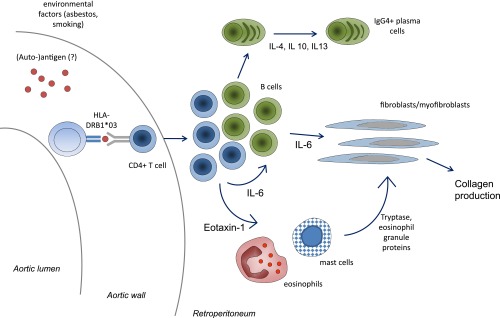Figure 2.
Immunopathogenetic mechanisms of idiopathic RPF. Susceptibility to idiopathic RPF is conferred by exposure to environmental agents (asbestos, smoking) and by genetic factors such as HLA class II alleles (HLA‑DRB1*03). The presence of a restricted HLA class II repertoire makes it likely that the disease is antigen-driven, although the triggering antigens are as yet unknown. Antigen-presenting cells present such hypothetical antigens to CD4+ cells within the aortic wall or the surrounding retroperitoneum. CD4+ T cells expand, secrete IL‑6, which is able to activate B cells and fibroblasts. CD4+ T cells also secrete Th2 cytokines such as IL‑4, IL‑10 and IL‑13, which drive B-cell expansion and maturation into plasma cells, and may lead to preferential expansion of IgG4-producing plasma cells. Lymphoid cells also secrete eotaxin‑1, which drives recruitment of eosinophils and mast cells, whose products are also able to activate fibroblasts. Once activated, fibroblasts mature into myofibroblasts and secrete collagen. This pathogenetic hypothesis and the resulting cartoon have been generated on the basis of the available evidence on the immunopathogenetic mechanisms of the disease. See text for further details.

